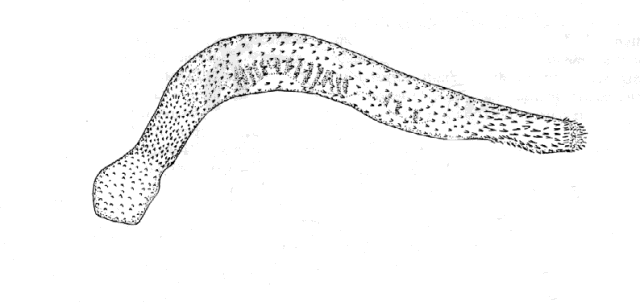|

|
Polychaetes
and other marine worms
Of course, there are many marine worms that are not polychaetes and cannot
be identified using this publication. Some worms, such as myzostomes and
pogonophorans, have been moved in and out of the Polychaeta as a result
of recent research. This rough guide may assist recognition of free-living
marine worms and worm-like invertebrates and reduce the confusion
about what is a polychaete and what is not. (Other worm-like organisms not
mentioned here occur in terrestrial and freshwater environments. Parasitic
worms are likewise not surveyed here.)
Even fragments of brittle star arms (ophiuroids) are occasionally mistaken
for segmented worms. Detached tentacles from such families as terebellids
and cirratulids are also commonly found in benthic samples. With a little
experience, worm-like fragments such as these are soon recognised and
discarded.
Annelida:
Hirudinea
leeches |
Leeches
are segmented worms with short thick muscular bodies with suckers
at either end. Segments and chaetae are present but are not easily
seen. |
![Hirudinea: Stibarobdella macrothela [illustrator: D.Kowarsky]](images/z0002446.JPG) |
| Annelida:
Oligochaeta |
Segmented,
coelomate, bilaterally symmetrical worms with tapering ends. Anterior
extremity, the prostomium, lacks appendages and is followed by the
peristomial segment with ventral mouth. Pygidium with terminal anus
at posterior extremity. Other segments are similar in form excepting
thickened opaque clitellum in sexually mature specimens formed of
up to 6 segments in the genital region. Chaetae are typically two
pairs of bundles per segment, include both hair-like capillaries and
simple or distally-toothed hooks. Compound chaetae absent. |
insert
oligochaete image |
Arthropoda:
Insecta
insect larvae |
Chironomids
and other dipterans (flies) have aquatic larvae that are segmented
and worm-like. Although predominantly freshwater, they can be quite
common in benthic samples from estuaries, and there are even a few
marine species. |
insert
insect image |
Cnidaria:
Anthozoa: Edwardsiidae
burrowing sea anemones |
(eg
the genus Edwardsia |
insert
edwardsiid image |
Chaetognatha
arrow worms |
Narrow-bodied
and often transparent, with paired lateral fins and a tail fin and
distinctive grasping spines at the mouth. Unsegmented. |
 |
Echinodermata:
Holothuroidea
sea cucumbers |
Holothurians
are sausage-shaped echinoderms, pentamerously symmetrical in cross-section.
Oral tentacles, arranged in a circlet, either bushy of digitate. Soft
bodied except for isolated calcareous ossicles in the skin. Tube feet
present or absent. |
![Holothuroidea: Chirodotidae [photo: M.Marmach]](images/Z0001894.jpg) |
Echiura
spoon worms |
Unsegmented
marine worms. Body short, wall thick and muscular. Proboscis simple
or bifid and non-retractile. Mouth at base of proboscis, anus at the
posterior end. Gut long and highly coiled. One pair of chaetae ventrally
immediatedly posterior to the mouth; 1-2 rings of chaetae may also
encircle the anus. |
insert
echiuran image |
Hemichordata:
Enteropneusta
acorn worms |
R:12
C:2 |
insert
hemichordate image |
| Mollusca:
Aplacophora |
Worm-like
burrowing molluscs that lack a foot and have a covering felt of calcareous
spicules. |
 |
Mollusca:
Bivalvia: Teredinidae
teredos or ship worms |
Wood-boring
bivalves with worm-like bodies and modified shell at the anterior
end, at the opening to the burrow, which has a calcareous lining. |
insert
teredo image |
| Mollusca:
Scaphopoda - tusk shells |
Molluscs
in a tapering, slightly curved calcareous shell. |
 |
| Myzostomida |
Worms
with inconspicuous segmentation, flattened discs (mostly), and commensal
on echinoderms, especially crinoids. Often classified within the Polychaeta
as Myzostomida or Myzostomidae but no longer thought to belong within
the Polychaeta. |
insert
myzostome image |
Nemertea
ribbon worms |
Unsegmented acoelomate bilaterally symmetrical worms. Digestive tract
with seperate mouth and anus, and an eversible proboscis dorsal to
the gut in a tubular cavity. The proboscis pore is ventrally located
at the anterior end. Most species nondescript in pigmentation, but
some have stripes, bands, spots or other distinctive patterns. |
![Nemertea [photo: M.Marmach]](images/z0001968.jpg) |
Nematoda
round worms |
Small
thread-like unsegmented worms, often with no obvious structure and
pointed at both ends, sometimes with copulatory apparatus. Cuticle
highly irridescent. |
insert
nematode image |
| Phoronida |
Phoronids
are tubiculous often constructing sandy tubes which resemble those
of the oweniid polychaete Owenia, with branchial crown but
lacking distinct segmentation or chaetae. Others are found embedded
in the tube walls of burrowing anemones. |
insert
phoronid image |
Platyhelminthes
flatworms |
Acoelomate
bilaterally symmetrical worms, strongly dorso-ventrally flattened.
Mouth ventral, gut sack-like, anus absent. Often brightly coloured
in life, tropical species spectacularly so. Free living, commensal
and parasitic forms. |
![Pseudoceros bifurcus [photo: L. Newman & A. Flowers]](images/z2660.jpg) |
| Pogonophora,
including Vestimentifera |
A
small conical prostomium and a peristomium bearing one, 2 or many
palps. Treated as Phyla separate from the Annelida by many authors
but now known to be polychaetes, family Siboglinidae |
insert
siboglinid image |
| Priapula |
Unsegmented
marine worms with bilaterally symmetrical bodies. Anterior region
is the introvert with mouth and eversible pharynx. Introvert with
20 or 25 longitudinal rows of chitinous papilla-like scalids. Posterior
region is the abdomen, with terminal anus. Abdomen with 30-100 circular
muscle bands visible as annulations. |
![Priapula [illustrator: Damon Kowarsky]](images/z0002443.JPG) |
Sipuncula
peanut worms |
Unsegmented
marine worms lacking chaetae. Body divided into a trunk and a slender,
retractable introvert with terminal mouth, often surrounded by tentacles.
Body usually with a distinctively "leathery" texture and covered with
papillae. Gut typically coiled in a tight helix. |
![Sipuncula [photo: M.Marmach]](images/49-30.jpg) |
|